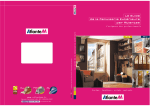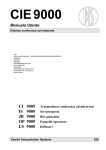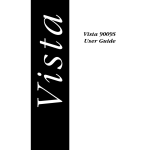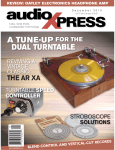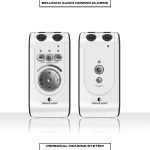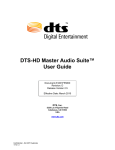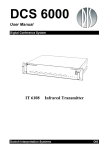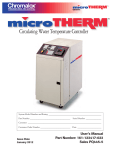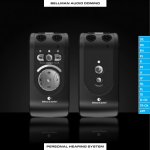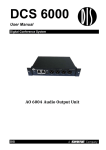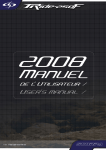Download CIE9000
Transcript
CIE 9000 User Manual Conference Interpretation Equipment CI IS JB OP LS 9005 9009 9000 9009 9000 Conference Infrared Transmitter Interpreter’s Set Junction Box Operator’s Panel Loudspeaker Danish Interpretation Systems DIS CIE 9000 LIST OF CONTENTS List of Contents Warning..................................................................4 Description.....................................................17 Locations and functions of controls ..............17 For all customers ...............................................4 Important ..........................................................4 Front plate sections...................................... 17 Front plate controls...................................... 18 Connectors................................................... 20 Caution................................................................4 Installation instructions .................................20 Important ...............................................................5 Intercom function...........................................21 Safety...................................................................5 Installation..........................................................5 Cleaning ..............................................................5 Repackaging .......................................................5 Warranty ............................................................5 Description of the System .....................................6 Where to place............................................. 20 Description .................................................. 21 Overview ..................................................... 21 JB 9000 Junction Box......................................21 Description.....................................................21 Where to place ...............................................22 OP 9009 Operator’s Panel..............................22 Description.....................................................22 Location and functions of controls ................23 Front plate controls...................................... 23 Features ..............................................................6 LS 9000 Loudspeaker......................................24 Description.....................................................24 Operation ...............................................................8 Connection to IS 9009 ................................. 25 Connection to OP 9009................................ 25 CI 9005 Conference IR-transmitter.................8 Description .......................................................8 Location and functions of controls ..................9 Front plate sections ....................................... 9 Front controls ................................................ 9 Rear panel connectors ................................. 13 System Enhancement..........................................26 Setting up a 8+1 system.................................26 Installation of optional BM 9009 Buffer Module...........................................................26 Installation hints .................................................27 Installation instructions..................................15 Where to place ............................................ 15 Ventilators................................................... 15 Removing 19"-brackets ............................... 15 How to open the unit ................................... 15 Cable lengths....................................................27 IS 9009 Interpreter’s Set................................27 OP 9009 Operator’s Panel: ............................28 Internal settings ..............................................15 Accessories .......................................................28 Beep level.................................................... 15 OP 9009 monitor source select.................... 15 Original sound level .................................... 16 Specifications.......................................................29 Preparation .....................................................16 Setting auto original mode .......................... 16 IR-radiator connection................................. 16 Connection to the interpreter’s booth .......... 16 Setting outgoing channels............................ 17 IS 9009 Interpreter’s Set .................................17 Electrical ..........................................................29 CI 9005 Conference IR-transmitter ...............29 IS 9009 Interpreter’s Set................................29 JB 9000 Junction Box....................................30 OP 9009 Operator’s Panel .............................30 LS 9000 Loudspeaker ....................................30 Copyright© 1996 DIS, Danish Interpretation Systems A/S No part of this publication may be reproduced or utilised in any form or by any means without permission in writing from the publisher. Manual no. 4412 2 CIE 9000 General..............................................................30 Power requirement .........................................30 Power consumption........................................30 Temperature to guarantee specified performance ...................................................30 Storage temperature .......................................30 Dimensions.....................................................30 Weight ............................................................30 Accessories supplied......................................31 Dimensions........................................................31 LIST OF CONTENTS CI 9005 Conference IR-transmitter ...............31 IS 9009 Interpreter’s Set, OP 9009 Operator’s Panel & LS 9000 Loudspeaker ......................32 JB 9000 P Junction Box (portable)................32 JB 9000 F Junction Box (flush mounted)......32 Pin assignments ...............................................33 IS 9009 Interpreter’s Set................................33 Headset connector (D9 male w/finger screws on cable) ...................................................... 33 Accessories (not supplied)...............................34 Schematics Standard System ................................................... A Enhanced System (8+1 channels) .........................B Copyright© 1996 DIS, Danish Interpretation Systems A/S No part of this publication may be reproduced or utilised in any form or by any means without permission in writing from the publisher. Manual no. 4412 3 CIE 9000 WARNING Warning For all customers The equipment has been tested and found to comply with the limits of the CE test. These limits are designed to provide reasonable protection against harmful interference when the equipment is operated in a commercial environment. The equipment generates, uses, and can radiate radio frequency energy and if not installed and used in accordance with the user manual it may cause harmful interference to radio communications. You are cautioned that any changes or modifications not expressly approved in this manual could void your authority to operate this equipment. The colours of the wires in the mains lead of this apparatus may not correspond with the coloured markings identifying the terminals in your plug, so please proceed as follows: The green-and-yellow wire must be connected to the terminal in the plug marked with the letter E or with the safety earth symbol or marked with greenand-yellow colour. The blue wire must be connected to the terminal marked with the letter N or marked with black colour. The brown wire must be connected to the terminal marked with the letter L or marked with red colour. Caution The apparatus must be connected to earth. Important The wires in the mains power lead are coloured in accordance with the following codes: Green-and-yellow: Earth Blue: Neutral Brown: Live Manual no. 4412 4 CIE 9000 IMPORTANT Important Safety Cleaning Check that the operating voltage of the unit is identical with the voltage of your local power supply. If a voltage conversion is required, consult your DIS dealer or qualified personnel. To keep the cabinet in its original condition, periodically clean it with a soft cloth. Should any liquid or solid object fall into the cabinet, unplug the unit and have it checked by qualified personnel before operating it further. Unplug the unit from the wall outlet or set the Main Power switch to OFF if it is not used for several days. To disconnect the cord, pull it out holding the plug. Never pull the cord itself. Installation Allow adequate air circulation to prevent internal heat built-up. Do not place the unit on a surface (rugs, blankets, etc.) that may block the ventilation holes. Do not install the unit in a location near heat sources such as radiators or air ducts, or in a place exposed to direct sunlight, excessive dust or humidity, mechanical vibration or shock. To avoid moisture condensations do not install the unit where the temperature may rise rapidly. Stubborn stains may be removed with a cloth lightly dampened with a mild detergent solution. Never use organic solvents such as thinners or abrasive cleaners since these will damage the cabinet. Repackaging Save the original shipping carton and packing material, they will become handy if you ever have to ship the unit. For maximum protection, repack the unit as originally packed from the factory. If not supplied with the equipment, a complete transportation and storage box system is available from DIS. We recommend you to use this system for long term protection and care. Warranty The individual units in the CDS 4000 is minimum covered by 12 months warranty against defects in materials or workmanship. Please further observe the installation hints provided in this manual. Manual no. 4412 5 CIE 9000 DESCRIPTION OF THE SYSTEM Description of the System Features A basic system consists of one CI 9005 Conference Infrared Transmitter and a number of IS 9009 Interpreters’ Sets. A suitable CDS microphone Conference Discussion System such as CDS 4000 for the delegates is required to form a complete system. The sound from this system is the “original” input to the CI 9005. The CI 9005 Conference Infrared Transmitter is a compact central transmitter unit used as the basic unit of a wireless infrared interpretation system. The CI 9005 features: • Auto relay • Compact design • High reliability • Crystal frequency control • Easy operation • Dual frequency selection per ch. • Dual test tone generator • 4+1 channels The CI 9005 contains the control and switching for the signals to and from the interpreters’ units, an crystal controlled master oscillator for the carrier wave frequencies, a FM modulator unit for 5 channels and a control panel allowing the technician to monitor the activity on any channel. The CI 9005 has a switch panel for selection of the interpreters’ outgoing A and B channels. The switches can be pre-set for any combination of channels. Each modulator unit is provided with a three-position switch for selection between two frequency channels or OFF. The chosen channel is shown with a 7-segment display. Manual no. 4412 The original channel has a pre-set level control and professional working AGC-circuit with a two LED level indicator. The other four channels have LED indicators for CHANNEL OCCUPIED and AUDIO. Further LED indication for BOX OCCUPIED, ALARMS and CALL is provided. Each modulator unit is equipped with a dual test tone generator. The delegates can hear the original language or the interpreted languages with infrared (IR) receivers or with wired channel selectors. A combination of IR- and wired simultaneous transmission is also possible. A number of IR radiators, such as the RA 15-8 or RA 15-24, will be used to distribute the FMmodulated signals with infrared invisible light for language distribution to the IR 15 series Infrared Receivers. The radiators are connected in daisy chain directly to the CI 9005 with BNC coaxial cables. For operating up to 135 wired channel selectors, such as the CS 12-series Channel Selectors, the CI 9005 must have the optional BM 9009 Buffer Module built-in. For operating a large number of Channel Selectors it is also possible to connect one or more external BA 9009 Buffer Amplifiers. Each delegate must have a headphone, stetoclip or earhanger e.g. the DH 9001 or DH 8004 Delegate Headphone, DH 8003 Stetoclip or DH 8002 Earhanger connected to the IR receiver or channel selector. A maximum of three IS 9009 Interpreters’ Sets and one LS 9000 Loudspeaker can be connected per interpreter’s booth. The IS 9009 features: • Two outgoing channels (A + B) • Automatic interlocking 6 CIE 9000 • Volume & separate tone controls • Cough button (muting) • Alarm button • Speaking too fast button • Full two-way intercom w. OP 9009 • XLR socket for GM 4022 Gooseneck Mic. w/light • 8+1 channels, (9+1 optional) The IS 9009 is a compact dual channel interpreter’s set designed to provide all the facilities needed by an interpreter. Each interpreter has one IS 9009 for individual use and a simple cable structure allows up to 3 sets plus one LS 9000 Loudspeaker to be linked in each interpreter’s booth. An automatic interlocking circuit prevents the use of a channel by more than one interpreter at a time. The IS 9009 has a selector for fast switching between speaker (Original) or any of the interpreted languages (Pre-select). By using the volume and separate bass & treble control buttons the interpreter can adjust the sound to the best listening comfort. The IS 9009 has a toggle switch for selection of the outgoing A or B channel. The A & B channels are easily pre-set on the CI 9005 Conference IRtransmitter. The channel setting may easily be changed at the request of the chief interpreter. Manual no. 4412 DESCRIPTION OF THE SYSTEM The IS 9009 has a large red illuminated microphone ON-OFF switch. Pressing the COUGH button may temporarily mute the microphone. An ALARM button is provided for signalling to the technician. A language display field is provided on top of the IS 9009 for easy identification of the outgoing languages. The IS 9009 has one ¼" jack and two 3.5 mm jack sockets (in each side) for headphones and one D9S socket on the bottom for headset connection. The microphone amplifier has a professional working AGC-circuit providing same listening level on all channels independent of the individual interpreters’ speech level. Two CI 9005 units can be connected to form a 9 channel (8+1) interpretation system. (10 channels available as option). An optional OP 9009 Operator’s Panel can be connected to CI 9005 for full two-way CALL function and monitoring of all functions. The CIE 9000 system conforms to all relevant standards for interpretation and the transmitter outputs (HF OUTPUT) comply with the relevant IEC standards for transmission using infrared radiation. 7 CIE 9000 OPERATION Operation CI 9005 Conference IR-transmitter Description CI 9005 is the central unit of the system and it provides all necessary central circuit for a system with four languages and original. The unit is in a chromatic and painted steel cabinet with an aluminium front. All materials are chosen to withstand severe climatic conditions such as in the tropics. The unit can be used as tabletop cabinet by removing the brackets or it can be rack mounted (19"-2HE). CI 9005 contains the power supply for the system. The mains input can be selected to a wide range of AC-voltages making world-wide use of the system possible. It has a balanced line input for the original sound (delegate microphones) with corresponding AGC (Automatic Gain Control) circuit and buffers. The unit also contains switching circuit for the Original sound and Call. Further it has controls for setting of the outgoing channels for each of the four interpreter boxes (A/B), AUTO original ON/OFF (auto floor), TEST TONES for testing the system and indicators for most of the functions. The Test Tones feature Manual no. 4412 different tones simultaneously for each channel and follow the selected transmission channel. The unit also contains five FM-modulators, one for original and four for the interpreted languages. Each one can be switched OFF or selected between two different IR-channels (carrier-frequencies). The five channels are mixed together and buffered to two separate 50ohm BNC-outputs, each capable of operating 20 or more infrared radiators of the RA 15 series. There is a monitor function on the front of the unit for testing and monitoring of all channels plus Auto Original (auto floor). It has channel selector, volume control and both ¼"-jack and 3.5mm-jack sockets for the headphone. An electronically balanced line output with original and all languages is provided for tape recorders, buffer amplifiers, etc. When an active loudspeaker is connected to the central unit, it is possible to have a one-way call system from each IS 9009 Interpreter’s Set to this loudspeaker which may be placed in the control room, at the chairman’s or at the user’s desk for call of documents, etc. The connection is made to the connector OPERATOR’S PANEL with a special cable. The SPEAKING TOO FAST function from the interpreters can also be remotely indicated and reset e.g. by the chairman or his secretary. This function is available in the 44 pin connector "OPERATOR’S PANEL” or "NEXT CI 9005". Two CI 9005 units can be interconnected to accommodate a system with eight languages and original. 8 CIE 9000 OPERATION Location and functions of controls Front plate sections The front plate is functionally divided into 6 sections. . Original sound, channel 0 (or 9) . Channel 1 (or 5) . Channel 2 (or 6) . Channel 3 (or 7) . Channel 4 (or 8) . Monitor section Each of the channel sections (B-E) are divided in an upper and lower part: The upper part with Channel display, Audio & Occupied indicators and Channel switch is the Outgoing part. 1 The Channel selector has 3 positions: OFF: Original audio sound is not transmitted to the delegates via the IRradiators. The Original audio is always present at all other outputs The lower part with A and B selectors, Alarm, Call & Occupied indicators is the language Box part, belonging in the master unit to boxes 1-4 and in the slave to boxes 5-8. CHANNEL 0: The Audio is transmitted on IR-Channel 0. Front controls 1 CHANNEL 9: The Audio is transmitted on IR- Channel 9. Input LEVEL indicator. Lights when sound is present at the ORIGINAL LINE IN connector. Manual no. 4412 Transmitter CHANNEL selector. 1 CHANNEL Indication. The 7-segment channel indication display will be OFF or show the number of the IRChannel. 9 CIE 9000 27 OPERATION delegates. OFF can be used if the beep function is not wanted. See instructions in the sections How to open the unit and Internal Settings - Beep Level. AUTO original switch. When ON the system operates in AUTO Original mode. 28 SPEAKING TOO FAST indicator. 1 Flashes when pressing the Speaking Too Fast button on the Interpreter’s Set. The indicator remains lit until Reset (8) is pushed momentarily. A beep sound is heard at the CI 9005. The Speaking Too Fast indicator and Reset button can also be remotely controlled from a custom made panel placed close to the chairman or at a speaker’s stand. These signals and information are provided in the sockets of Operator’s Panel or Next CI 9005. 1 RESET button. This button resets the Speaking Too Fast indication, the Alarm indication and the Test INPUT LEVEL Adjustment for input audio sound. This should be adjusted in such a way that the green Input Level Indicator (1) flashes correspondingly to the audio and that the yellow Input Level Indicator (1) lights up occasionally when the audio level is extra high. Tones. 8 The green AUDIO indicator flashes concurrently with the level of the audio signal ON. If the audio level is correct, the indicator should flash brightly. NOTE: The original sound can make feedback if a delegate who is going to speak, takes off the headphone and places it close to the microphone. This is caused by the AGC raising the level before the speech starts. If this happens, turn down the INPUT LEVEL until the feedback (howling sound) stops. 2 Hole for BEEP Sound. The BEEP is transmitted through the small hole. The sound level can be selected to High, Low or Off. The selection is done behind the front plate with a small jumper. HIGH (factory setting) is provided for use in the control room. LOW is provided for portable jobs, as the CI 9005 is often placed in the same room as the Manual no. 4412 AUDIO indicator. 9 Transmitter CHANNEL selector. The Channel selector has 3 positions. OFF: The channel audio sound is not transmitted to the delegates via the IRradiators. But the audio is still present at all other outputs. CHANNEL 1: The Audio is transmitted on IR-Channel 1. CHANNEL 5: The Audio is transmitted on IR- Channel 5. The Audio channels can be changed from 1 to 5 on the transmitter. 10 CIE 9000 Therefore the interpreter “going out” on e.g. channel 1 (selected with the BOX rotary switch) will always “go out” on the same number of channel on the LINE OUT CHANNEL 0-8 connector and on the CHANNEL SELECTOR connector. OPERATION 16 The A rotary switch selects the Outgoing A channel for the corresponding booth. When an interpreter switches On his microphone with his Outgoing toggle switch in position A, he will "go out" on the selected A Audio channel number. The other 3 channels function in a similar way. 10 Outgoing A channel. Channel OCCUPIED indicator. Lights when the audio on this channel is coming from an interpreter. When OFF, the audio will be original. 11 Channel Indication. The 7-segment channel indication display will be OFF or show the number of the IRChannel. 12 Outgoing B channel. The B rotary switch selects the Outgoing B channel. When an interpreter switches On his microphone with his Outgoing toggle switch in position B, he will "go out" on the selected B Audio channel number. 13 Box OCCUPIED indicator. Lights when the box is occupied i.e. one of the interpreters has switched On his microphone at either A or B OUTGOING channel. 14 CALL indicator. Lights when an interpreter in the corresponding booth is using the CALL function. 15 ALARM indicator. Lights when an interpreter in the corresponding booth has pushed the Alarm button on the Interpreter’s Set. Light remains until Reset is pushed momentarily. A beep sound is heard at the CI 9005 at the time the interpreter pushes his Alarm button. Manual no. 4412 17 TEST TONES indicator. The red indicator lights when TEST TONES are ON. 18 POWER switch. Power to the CI 9005 and all connected units (except a second CI 9005 with connected units) are switched On and Off with this switch. The green indicator in the switch lights up when power is present. This indicator has also another function: The power supply is divided in three sets of +15V and -15V. One set is for CI 9005 itself and OP 9009 Operator’s Panel. Second set is for BOX 1 and 2, and the third is for BOX 3 and 4. If the voltage of one or more of the six supplies drops more than 10%, the POWER LED will flash. This can indicate a fault (e.g. short circuit in an extension cable) in the connected equipment. The fault can be located by disconnecting the equipment piece 11 CIE 9000 OPERATION by piece until the LED again shows a steady light. This gives a clear indication of the location of the fault. All six supplies are short circuit proof and temperature protected. The unit has two secondary internal fuses to protect against component failure. Please contact your dealer, DIS or other qualified personnel if these fuses blow. 19 Monitor Headphone jacks. Connection for a headphone either with a standard ¼" jack or a 3.5 mm mini jack connector. Both mono and stereo headphones can be used. 20 VOLUME control. Adjusts the listening level of the monitor headphone jacks. 21 MONITOR switch. Selects which channel you wish to monitor on the headphone jack sockets. Position 1-8 monitors audio channels 1 to 8. Position "OR" monitor the AUTO original channel. Normally original will be present here, but when an interpreter "goes out" on a B channel, the green indicator AUTO will light Manual no. 4412 up and this interpreter will be heard at the OR position (assuming AUTO slide switch is ON). 22 TEST TONES button. The TEST TONES button alternately switches On and Off the built-in Test Tones. It is only possible to switch On the Test Tones when all occupied indicators are Off. The tones stay on until Test Tones button or Reset button is pushed. If two CI 9005s are connected, all tone generators will be affected by pushing the buttons on each unit. The two units may come out of On/Off synchronisation. Pushing the RESET button will always correct this. The Test Tones follow the selected channel with the lowest frequency for the lowest channel number. If a channel is OFF, there will be no Test Tone on the corresponding Audio channel. The red indicator lights when TEST TONES are ON. 12 CIE 9000 OPERATION Rear panel connectors 1 MAINS connector. Connects the supplied AC power cord (mains lead). 1 The mains voltage can be selected to 110V, 130V, 150V, 220V, 240V and 260V +/-10%. To change the setting, remove fuse holder with a screwdriver: Push in and turn anticlockwise. Use a coin to turn selector; press in before turning. Caution. Note that the mains FUSE must be changed to 3.15AT (3.15A slow blow) for 110V to 150V and to 1.6AT (1.6A slow blow) for 220V to 260V. Both types of fuses are delivered with the unit. Always replace fuse with same type. Do not change fuse with power cord connected. Neglecting to follow these precautions will severely jeopardise the safety regulations. NEXT CI 9005 D9S. The NEXT CI 9005 D9S connector is used for combining two CI 9005s. AUTO original signals are connected through this connection. 1 LINE OUT CHANNEL 0-8 connector. HF OUTPUT connector. Output connectors for connecting IRradiators. VOLTAGE SELECTOR. Sets Voltage selector at the rear side for the correct mains voltage. 1 1 1 NEXT CI 9005 BNC connector. Connection to a second CI 9005. This input/output mixes the FM-modulated signals from two connected CI 9005 units. 1 CHANNEL SELECTOR connector. Connector for the optional Channel Selectors (when fitted with the optional BM 9009 Buffer Module). 1 ORIGINAL LINE IN connector. The Original Line In connector is provided with a standard audio XLR 3-pin socket. The input is electronically balanced and accepts input levels between approx. 100mVRMS and 5VRMS. The input circuit incorporates an advanced AGC (automatic gain control) and LIMITER, which keeps the audio level within a small range. The AGC regulates the gain slowly up and down depending on the RMS level of the audio signal. The limiter quickly turns down the gain when loud sounds occurs and up again afterwards. Connection for multi-channel tape recorder. Manual no. 4412 13 CIE 9000 2 MASTER/SLAVE switch. The MASTER/SLAVE slide switch must always be in the Master position when only one CI 9005 is used. OPERATION 3 Connectors of BOX 1 to BOX 4 for connection to max. four interpreters’ booths. 4 When two CI 9005s are used (optional), the switch on the first CI 9005 must be placed in Master position and the switch on the second CI 9005 must be placed in Slave position. In the Slave position the original input is disconnected and instead taken from the master unit. The input to the first transmitter channel (0/9) is disconnected, and input of the four next transmitter channels are switched from audio-channel 1-4 to audiochannel 5-8. Manual no. 4412 BOX connectors. NEXT CI 9005 HD44S connector. The NEXT CI 9005 HD44S connector (30) is used for connection of two CI 9005s. Most audio and control signals are connected through this connection. 5 OPERATOR’S PANEL connector. Connects the optional OP 9009 Operator’s Panel. If two CI 9005s are used together for an 8+1 channel system, the OP 9009 Operator’s Panel must be connected to the master unit. Only one panel can be connected. 14 CIE 9000 OPERATION Installation instructions Where to place Removing 19"-brackets The CI 9005 unit can be placed on a table. Do not place anything on the unit as the unit will overheat and stop functioning correctly. If the unit has become overheated, turn Off the power, remove things that prevent proper ventilation and wait until it has cooled down. Then turn On again. If the unit is placed on a table and the brackets are not used, then these can easily be removed. Screw out the two screws holding each bracket; remove the brackets and screw in the screws again. Be careful, do one side at a time as these screws also hold the cabinet together. CAUTION: Do not remove rubber pads in bottom, as they are needed for proper ventilation. How to open the unit The CI 9005 can also be installed in a 19"-rack using the holes in the brackets on each side. CAUTION: It is important to have at least one blank 1HE-high front plate over and under the CI 9005, to keep sufficient ventilation. Ventilators It may be necessary to have ventilators in the rack over or under the unit(s) if e.g. two CI 9005 units are placed in the same rack. The ventilators are only needed to give a small amount of airflow up through the units. A blank 1HE-high front plate should also be placed between the two CI 9005s. Take out mains plug. Place the unit on a table. Remove the two upper screws in each side. Remove upper screw in the top middle of back plate. Now lift approx. 1.5 cm up the back of the top lid, so the inside bracket at the middle back of the lid is free of the back plate. Then slide the lid backward away from the front plate until the front bracket releases (approx. 2 cm). Remove top lid. CAUTION: Never open unit with power cord connected. Do not operate unit with cover removed to avoid a potentially dangerous shock. If any trouble arises that cannot be rectified by external checking of the CI 9005 and connected units, then you should approach your dealer or order service by qualified personnel. Internal settings Beep level OP 9009 monitor source select The BEEP level is selected inside at the left side of the front plate. A small 4-pin connector is placed on top of the front plate circuit board. Simply move the 2-pin jumper to the wanted position for HIGH, LOW or OFF. See text on circuit board. The source for the monitor channel 0 of OP 9009 Operator’s Panel can be selected to original or AUTO original audio channel at the big bottom circuit board. Two 3-pin connectors with a 2-pin jumper are placed just below the voltage selector. Both jumpers must be to the same side. See text on circuit board. Manual no. 4412 15 CIE 9000 Original sound level The level for ORIGINAL on channel 1-9 can be selected between normal and low with a jumper on the bottom circuit board. It is placed close to the back under the small flat cable. See text on circuit board. The low setting can be useful if problems OPERATION with feedback between the headphone of a delegate and his microphone arise. This may happen if a delegate takes off his headphone and places it near an open microphone. The normal setting gives same level on all channels for both original and interpreter sources. The setting does not affect the AUTO and OR channel. Preparation Setting auto original mode The interpreters use AUTO Original when "relay"interpretation is needed. Relay means that an interpreter in stead of interpreting from original (as usual) interprets from another already interpreted channel. This is needed if he (and/or his partners in the booth) does (do) not understand the spoken language of the original. The language booth which normally interprets to this language is not working on the A channel now as this languages is spoken in original. In stead this booth will "go out" on the B channel and will interpret from the normally outgoing language to the B channel language, being a more commonly understood language (e.g. English). All interpreters who have chosen to listen to the AUTO original channel will now automatically hear the interpreter going out on his B channel in stead of the original, and will interpret into their corresponding languages and will be on relay of the first interpreter. It is only meaningful for one interpreter at a time to go out on B in the case of AUTO original ON. A flashing indicator on the Interpreter’s Set will warn if more than one goes out on B. More interpreters will then be heard on the OR channel at the same time. The AUTO switch is only active on the MASTER CI 9005. Manual no. 4412 When AUTO is OFF, the AUTO original channel will always be original and all booths can go out on different B channels at the same time. The small green AUTO indicator below OR at the Monitor Channel Selectors on CI 9005 and IS 9009 will light up when the AUTO original channel has an active B channel. IR-radiator connection The two HF-OUTPUT BNC sockets are for connection of up to or more than 20 IR-radiators each. Always use 50 ohm-coax cables with 50 ohm BNC connectors for distribution of the signal. The radiators must always be daisy chained and the last radiator must be terminated with 50ohm. Neglecting this may create problems of poor transmission, especially for the high channel numbers. Connection to the interpreter’s booth Connection of the IS 9009 Interpreters’ Sets to the BOX connectors (1-4) on the CI 9005. Extension cables and JB 9000 Junction Box (if more than one IS 9009 in each booth) are normally needed for each both. Always use the finger screws to keep the connectors correctly mated. Prevent plugging in and out while power is ON as this will cause small sparks in the connectors which in time will burn away the gold plating making a poorer connection. This should only be done in an emergency situation. 16 CIE 9000 Setting outgoing channels Set the outgoing A and B selectors to 1 for channel 1, set to 2 for channel 2, etc. If an interpreter in e.g. OPERATION Booth 1 can interpret into two languages, his outgoing B selector shall be set to the channel normally used for this language. IS 9009 Interpreter’s Set Description On the front plate the IS 9009 has an XLR socket for the GM 4022 Gooseneck Microphone (with integrated ON-lamp). On each side of the console is a 3.5mm jack socket for headphone and an extra ¼"-jack socket on the right side for professional headphones. All sockets can be used at the same time. For each language booth it is necessary to have at least one IS 9009 connected. Normally there will be two or three interpreters per language booth with one IS 9009 for each interpreter. It is possible to connect three IS 9009s by using the JB 9000 Junction Box in each booth. One LS 9000 Loudspeaker can be connected to the JB 9000 Junction box as well. The headset connector is placed beneath the IS 9009. This connector is for use with headsets having built-in microphone in stead of using the gooseneck microphone on the front plate. The connector can accept many different headsets, e.g. the IH 9001 Interpreter’s Headset series. IS 9009 has a microphone amplifier with a similar AGC-circuit as provided for the original sound. The sound level on all channels are in this way kept within a small range making switching between channels comfortable without the need to adjust the volume. Locations and functions of controls Front plate sections The front plate is designed with all listening controls together with ALARM and SPEAKING Manual no. 4412 TOO FAST buttons placed on the left side and all outgoing controls on the right side. 17 CIE 9000 OPERATION Front plate controls 7 The indicator stays On until the operator signs for the message by pressing the Reset button on the CI 9005. The Reset button can also be remotely controlled from a custom made panel placed close to the chairman. ALARM button. When pressed, a beeper will sound at the CI 9005 in the control room and an indicator will switch On showing in which booth the alarm is pressed. The indicator stays On until the operator signs for the alarm by pressing the Reset button on the CI 9005. 7 XLR3S standard microphone connector primarily intended to be used with GM 4022 Gooseneck Microphone with light. The indication and reset can also be remotely controlled from a custom made panel placed close to the chairman. 7 The microphone ensures good sound even at some distance (0-0,75m). The input is electronically balanced with a 9V phantom supply. SPEAKING TOO FAST button. When activated, a beeper will sound in the control room and an indicator will start flashing. Manual no. 4412 MIC connector. 7 INTERCOM button. Press to call the operator. 18 CIE 9000 7 OPERATION The delegates will hear original as long as there is no interpreter on at the channel and when the Mic button is activated the sound will switch from original to the interpreter’s microphone. INTERCOM indicators. The red light indicates Intercom function occupied. When steadily lit, the green indicates Outgoing call and when flashing Incoming call. 7 7 7 OCCUPIED indicators. Red Occupied indicator for the outgoing channel A and B. Lights whenever the channel is occupied (also when occupied by itself). If Auto is selected ON at the CI 9005, the B indicator will flash in those IS 9009s where the interpreter goes out on the B channel and another interpreter also goes out on B. 7 7 The microphone can be switched On if the outgoing channel is not occupied. Manual no. 4412 AUTO indicator. Indicates if the Auto is switched On at the CI 9005 central unit. 7 VOLUME control. Control for adjusting headphone sound level. The control has ample gain even to hear people talking far away from an open microphone. The volume controls all three phone outputs. MIC button. Switches On and Off the microphone when pushed momentarily. The button and the ring light in the microphone lights up when the microphone is ON. RELAY rotary selector. Selection between OR (in original) or language channel 1-8. In this way it is possible to do "relay"-interpretation. When AUTO is switched On at the CI 9005 central unit, the OR position also has the AUTO original (auto floor) function. When the green AUTO indicator lights, the interpreter going out on the B channel is heard. If no interpreters are using the B channel, the floor sound is heard. If the key is changed when the microphone is ON, the microphone will stay ON if the new channel is not occupied. The microphone goes OFF if the new channel is occupied. 7 RELAY/ORIGINAL switch. Toggles between Original (floor sound) and Relay sound (one of the other interpreters). A/B switch. Outgoing toggle switch. This key switches between the normal outgoing box language A and the outgoing language B. The actual selection of languages are pre-set at CI 9005. MUTE button. Mutes the microphone when pressed. The Mic On indication also turns Off when MUTE is pressed, but the outgoing channel is still occupied as the microphone is still ON. The delegates will hear a muted channel. LABEL field. Holder for inserting language symbols for the A and B language. A piece of white cardboard or paper (approx. 55x37mm) with the A-language written on the left half and the B-language written on the right half can be inserted from the side as a help for the interpreters. 7 7 7 BASS control. This control can steeple both attenuate (-) and enhance (+) lower frequencies. +/-12dB at 125Hz with respect to 1kHz. 19 CIE 9000 2 OPERATION TREBLE control. This control can steeple both attenuate (-) and enhance (+) higher frequencies. +/-12dB at 8kHz with respect to 1kHz. Connectors Connection cable. The IS 9009 is supplied with a permanent 2m long cable to be connected to the CI 9005 Conference IR-transmitter. This is normally done via the JB 9000 Junction Box and extension cables of various lengths. The maximum length of extension cable between CI 9005 and the language booth is 300m (approx. 1000 feet). A maximum of three IS 9009s and one LS 9000 Loudspeaker can be connected in each booth. 2 Headphone jacks. The IS 9009 has a 3.5mm jack socket at both the left and right side of the unit for free choice of plugging in the phone cables. Also possible to use headphones with 1/4”-jack in the right side. 18 Headset connector. D9S female connector for headset. Different types of headsets can be connected to this connector. Please contact your dealer or DIS distributor for information of how to connect your type of headset. The connector features possibility of using both dynamic and electret microphones; balanced or nonbalanced. Installation instructions Where to place have a min. dimension of either Ø60 or 17 x 60mm for the connector to drop through. The IS 9009 can be placed on the table top. This is convenient for the interpreter as he can place it where he wants. The cable should preferable run away from the interpreter and through a hole in the table close to the booth window. The hole must The IS 9009 can also be permanently mounted on the table using two screws and washers. As the cable comes out on the side, it is possible to place IS 9009 close to the front wall of the booth. Manual no. 4412 20 CIE 9000 OPERATION Intercom function Description When the Call button is pushed, both indicators will light up. The red indicates that the call line is occupied, and continued light in the green indicates that the microphone is open for calling. The call function is active as long as the button is pressed. The indication will not change if there is an answer back from OP 9009, but the answer will be heard with the chosen listening channel attenuated. The OP 9009 can only answer back if the booth is free. When a call is made from the OP 9009 Operator’s Panel, the red LED also lights up indicating that Call is used and the green LED flashes indicating a call from OP 9009. A call from OP 9009 can only be made when the booth is free. When an interpreter answers by pressing the CALL button, the flashing green LED will become steadily lit indicating the microphone is ON. If the Microphone is ON and the CALL button in the same set is activated, the MIC lamp will turn OFF indicating that the outgoing sound is muted. Red and green leads will also light up indicating Call is open. The channel stays occupied by the IS 9009. It is not possible for the other interpreters in the booth to make calls if one IS 9009 is occupying a channel. Overview Mic indicator Red call indicator Green call indicator Possible call function Off Off Off Call line is free. You may call. On Off Off Call line is free. You may call. Other Mic in box On Off Off You can not call. On or Off On Off Call line is occupied. Call not possible Off On Flashing Call from OP 9009. You may call back Off On On You are calling or answering back JB 9000 Junction Box Description The junction box has one connection to the CI 9005 and four sockets for up to three IS 9009 Interpreters’ Sets and one LS 9000 Loudspeaker. The junction box is available in two versions: The JB 9000 P including 1m fixed cable with male plug for portable set-up or mounting on the wall. One set of adhesive locking fasteners will be included to fix the box under the table. Manual no. 4412 21 CIE 9000 OPERATION Where to place The other version JB 9000 F is delivered without box and cable and designed for permanent flush mounted installations in cable ducts. The connections are made with easily connected springloaded terminal strips. The JB 9000 P Junction Box should be placed under the table plate itself or on the wall under the table. The adhesive fasteners or the knocking-out holes for screws in the bottom of the junction box can be used for placing the box. If plastic trunks are used for the cables, the JB 9000 F can be placed in a 86 x 56 mm (W x H) hole. The front plate is screwed on the front of the cable trunk with four screws and nuts. OP 9009 Operator’s Panel Description the operator who can answer back in full duplex if the booth is not occupied. Indication shows from which booth the call is made. The operator can call one or all booths not interpreting. One interpreter at a time can answer back or make a call. The panel monitors the four (or eight) language channels plus original and incorporates most of the indicators present on the CI 9005 Central Unit. It has connectors for both headphones (as on the IS 9009) and for external loudspeaker (LS 9000). It also contains a two-way call system. For this it has a connector on the front plate for a GM 4022 Gooseneck Microphone. The interpreter can call Manual no. 4412 When the interpreters receive a call, they will hear the operator at normal level, but the original sound (or other) is attenuated making it possible for the interpreters to follow the speech from the floor when the call is made. The Test Tones and Reset of Alarm or Speaking Too Fast can also be controlled from the panel. It is only possible to connect one OP 9009 Operator’s Panel to one CI 9005 or to an interconnected system with two CI 9005s. 22 CIE 9000 OPERATION Location and functions of controls Front plate controls 7 7 Lights when an interpreter has pushed the Alarm button on the Interpreter’s Set. TEST TONES button. The TEST TONES button alternately switches On and Off the test tones. It is only possible to switch On the Test Tones when all occupied indicators are Off. The red indicator lights when Test Tones are ON. 7 MIC connector. XLR3S standard microphone connector primarily intended to be used with GM 4022 Gooseneck Microphone with light. The microphone ensures good sound even at some distance (0-0.75m). The input is electronically balanced with a 9V phantom supply. Manual no. 4412 ALARM indicator. The light remains until Reset is pushed momentarily. A beep sound is heard at the CI 9005 when the interpreter pushes the Alarm button. 7 SPEAKING TOO FAST indicator. Flashes when an interpreter has pressed the Speaking Too Fast button on an Interpreter’s Set. The indicator remains flashing until Reset is pushed momentarily. A beep sound is also heard at the CI 9005. 23 CIE 9000 7 Press to call all interpreters. RESET button. This button resets the Speaking Too Fast indication, the Alarm indication and the Test Tones. 7 OPERATION 9 CHANNEL selector. Selects the channel, which is monitored on the headphone jack sockets and on the LS 9000 Loudspeaker connected to the OP 9009. Indicator panel. Position 1-8 monitors audio channels 1 to 8. Position "OR" monitors either the AUTO original channel or the original channel depending on the internal selection in the CI 9005. 10 The indicator panel consists of 4 indicators for each BOX: CHANNEL OCCUPIED: Indicates the occupied outgoing audio channels. 11 Mixer control. This control gives the possibility to mix original sound together with the channel sound selected with the CHANNEL selector. INT. CALL: Indicate call from an interpreter. This mix is only present on the headphone jack sockets and not on a connected LS 9000 Loudspeaker. CALL buttons (1 to 8). Press to call the interpreter booth 1 to 8. 8 Adjusts the listening level for the monitor headphone jacks (and NOT the volume on a connected LS 9000). BOX OCCUPIED: Indicates the boxes where the MIC button on the IS 9009 is activated indicating that an interpreter is “going out” on either his A or B channel. OPER. CALL: Lights when the CALL button is activated. 7 VOLUME control. When turned fully counter clockwise only original sound is present; when turned fully clockwise only the selected channel sound is present. ALL CALL buttons. LS 9000 Loudspeaker Description Manual no. 4412 24 CIE 9000 OPERATION The unit has a volume control and power amplifier for the loudspeaker. Output will always be original. The unit can be placed on the table or mounted on the wall. Connection to OP 9009 The LS 9000 can also be connected to the OP 9009 Operator’s Panel. Connection to IS 9009 One loudspeaker can be placed in each interpreter’s booth giving the interpreters the possibility to put down their headphones and rest their ears while the booth language is spoken in original language. A relay in LS 9000 mutes the loudspeaker whenever an interpreter’s microphone in the belonging booth is going out to the delegates. Manual no. 4412 It gives the operator the possibility to put down the headphone and listen to the sound selected with the CHANNEL selector at the OP 9009. If an interpreter calls the operator by the built-in Intercom System, the call will also be heard in the LS 9000. This level is factory set and cannot be adjusted. 25 CIE 9000 SYSTEM ENHANCEMENT System Enhancement Setting up a 8+1 system Two CI 9005 units can be interconnected to accommodate a system with eight languages and original. Only three extra interconnection cables are needed; all other circuit needed for 8+1 channels are already built-in. The interconnected system has four HF-outputs each with 8+1 channels for even bigger set-ups of infra-red radiators in large rooms. Also available are two separate line outputs for use for tape recorders, buffer amplifiers, etc. If both units include the optional BM 9009 Buffer Modules, it will also provide outputs for wired channel selectors for 2x135 delegates. With one BM 9009 present there is output for one zone of 135 delegates with all 8+1 channels. From the left hand the sections belong to ORIGINAL sound and AUDIO channels 1-4 in the MASTER. (Set the MASTER/SLAVE to MASTER on this unit). The left hand section in the SLAVE must always be OFF. The other sections in the SLAVE belong from the left to AUDIO channels 5-8 (set the MASTER/SLAVE to slave on this unit). Installation of optional BM 9009 Buffer Module Open the unit (se how to open in previous section). Turn the unit upside down when the top lid has been removed. Take the bottom lid away just like the top lid. Unscrew the screws on the two left side brackets holding the bottom board. NB. Be careful not to stress the unit when it is moved, as the bottom board alone holds all together. Lift it holding on the right side. The left side with the two brackets is now lose. Take it off and remove the two brackets from the side. Mount the brackets on the heat sink sides of the buffer module with the four M4 screws. Use the inner holes. NB. Be sure that the two flaps with the threaded holes turn away from the heat sink. Place the buffer module in the unit so the D-sub connector passes through the rectangular hole in the back plate. Put on the side plate (turn correctly) and screw in the four countersunk M3 screws to the brackets. Screw bottom board on the two brackets from the bottom with the two M3 screws and toothed disks. Assemble bottom lid. Insert the flat cable connector into J25 connector in the bottom board. Insert the 4-pole power connector from the mains power transformer to J3 on module. Check that everything looks correctly and nothing has been forgotten inside the unit. Assemble top lid. The unit is now ready for use Manual no. 4412 26 CIE 9000 INSTALLATION Installation hints Cable lengths IS 9009 Interpreter’s Set The power consumption of the connected units and the resulting voltage drop in the cable will limit the cable lengths between the CI 9005 Central IRTransmitter and the connected units, i.e. IS 9009 Interpreter’s Set, LS 9000 Loudspeaker and OP 9009 Operator’s Panel. The sound quality will also be slightly influenced, but mounted properly with correct cable types all specifications will be at least as stated. LS 9000 is used. The number of channels used does not matter as each box uses its own cable. The same is the case if two linked CI 9005 units are used for more than four languages. Below table shows the max. cable length that can be used without degrading the performance of the systems specifications for both standard extension cables (25x2x0,14 mm2 screened) and with the next size of cable (25x2x0,25 mm2). The length will depend on the number of IS 9009 units used in the interpreter’s box and whether an Number of units IS 9009 LS 9000 2 2 3 3 0 1 0 1 Max. cable length 25x2x0,14mm2 (standard cables) 245 m 155 m 175 m 125 m Note: It is difficult or even impossible to squeeze the big cable into the shells of the connectors. It is recommended to use JB 9000 Junction Boxes for mounting in cable ducts in each interpreter’s box as it is much easier to put the cables into its spring loaded tie points. Wall mounted connectors behind the CI 9005 are also recommended as short (2m) standard cables can be used between central unit(s) and the wall connectors. In many countries standard wall brackets/boxes normally used for data purposes are available for D25-connectors. These can be used for the HD44-connectors as they have the same mechanical measures. DIS can Manual no. 4412 25x2x0,25mm2 445 m 275 m 315 m 225 m supply the connectors with shells and finger screws or hex nuts for cable use and connectors with hex nuts for mounting in plates. Note: Do not try to place more HD44S-connectors in the interpreter’s box in parallel just as in the JB 9000, as it is almost impossible to solder two cables in parallel on one connector. Always use JB 9000 either for built-in with spring loaded tie points or JB 9000 for portable use, which only have one male connector on the cable. The box can easily be either screwed to the wall or placed under a table with adhesive tape. 27 CIE 9000 INSTALLATION OP 9009 Operator’s Panel: Length between CI 9005 and OP 9000: Number of units OP 9000 LS 9000 1 0 1 1 Max. cable length 25x2x0,14mm2 245 m 155 m 25x2x0,25mm2 445 m 275 m Accessories Extension cables and accessories are available according to below table: EC 9009 EC 9000-05 EC 9000-10 EC 9000-20 EC 9000 EC 9000 EC 9000 EC 9000 EC 9000 CA 9000 CA 9000 CO 9000 CO 9000 CO 9000 CO 9000 Pre-terminated Cables Interconnection Cables between 2 CI 9005, when forming a 9-channel system. Cable, 5 m, (between CI 9005 and JB 9000 or IS 9009 or OP 9009) Cable, 10 m, (between CI 9005 and JB 9000 or IS 9009 or OP 9009) Cable, 20 m, (between CI 9005 and JB 9000 or IS 9009 or OP 9009) Cable adapter , 0.5 m, (between OP 9009 and LS 9000) Cable, 2 m, (between CI 9005 and CDS 4000) Cable, 5 m, (between CI 9005 and CDS 4000) Cable, 10 m, (between CI 9005 and CDS 4000) Cable, 20 m, (between CI 9005 and CDS 4000) Cables Cable per 100 m, (between CI 9005 and JB 9000 or IS 9009 or OP 9009) Cable per 100 m (between CI 9005 and CDS 4000) Connectors Connector, HD-sub, 44 p male, w/cap Connector, HD-sub, 44 p female, w/cap Connector, XLR, 3 p male Connector, XLR, 3 p female Order no. 5481 5478 5479 5480 3047 7101 6223 6694 6697 3034 2914 3032 3033 3001 3002 . Manual no. 4412 28 CIE 9000 SPECIFICATIONS Specifications Electrical CI 9005 Conference IR-transmitter Number of ch.: 5 Channel frequencies to be switched between: Ch.: 0/9: 1/5: 2/6: 3/7: 4/8: Test Tone: 498/849 Hz 537/693 Hz 576/732 Hz 615/771 Hz 654/810 Hz Oscillator: Modulation: Frequency: 55/415 kHz 95/255 kHz 135/295 kHz 175/335 kHz 215/375 kHz Crystal controlled. (PLL) Frequency Modulation. Audio range of modulator: Pre-emphasis: Deviation: Distortion: Crosstalk: HF outputs: HF-output load imp.: Original Line Input: Impedance: Input level: Max. input level: AGC range: Limiter range: Connector: 100 Hz - 12.5 kHz. 100 us +/-6 kHz (peak +/-7kHz) < 1,5% < -66dB/1kHz 2 nos. BNC 50 Ohm 40 kOhm, Balanced Adjustable 100 mV-1,55 V +20 dBm (8V) 20 dB 20 dB XLR3S Line Output: Balanced multi-channel 0-8 ch. for recording purposes. Load: >600 Ohms/ch. Level: 0 dBm (0,7V) Frequency: 100 Hz - 15 kHz Crosstalk: < -66 dB/1kHz S/N ratio: > 70 dBA Distortion: < 0,1 % Connector: D25S Optional Output: Buffer module BM 9009 Manual no. 4412 Balanced multi-channel output, 0-8 ch. for connection of cable wired channel selectors for delegates (max. 135). Load: > 4 Ohm Level max.: +20 dBm Dist.: < 0,5% Freq.: < 125Hz-12,5kHz S/N ratio: > 70 dBA Connector: HD 26S Other Connections: 4 I/O sockets for Interpreter’s Set (IS 9009) and Loudspeaker (LS 9000): HD44S 1 I/O socket for Operator’s Panel OP 9009: HD44S 3 I/O sockets for expanding with one more CI 9005 to 8+1 ch.: HD44S + BNC + D9S IS 9009 Interpreter’s Set Number of incoming channels: 9 (Original + 8) Optional 10 (Original +9) Number of outgoing channels: 2 (A & B) Mic. In: Impedance: 2 kOhm XLR3S connector for GM 4022 Gooseneck Mic. w. light. D9S socket with gain setting facility for use of a variety of different headsets. + and - 9 Volts available for electret type mic. Mic. out: Level: 0 dBm (775mV) Frequency range: 100 Hz - 15 kHz Distortion: < 0,1 % Signal to Noise ratio: > 70 dBA Headphone Output: Load: >30 Ohm Level: 1,5 Volt Frequency range: 100 Hz - 15 kHz Distortion: < 0,1 % Signal to Noise ratio: > 70 dBA Crosstalk attenuation: > 66 dB/1 kHz Sockets: 2 x 3,5 mm + 1 x 1/4", stereo jack. 29 CIE 9000 Connector: SPECIFICATIONS HD 44P for connection to CI 9005 JB 9000 Junction Box Connections: Four HD44S sockets for IS 9009 Interpreter’s Set and/or LS 9000 Loudspeaker. One cable for connection to CI 9005 Conference Transmitter. Cable length: 2 m. Connector: HD44P. OP 9009 Operator’s Panel Number of ch.: 9 (Original + 8) Selection between OR or AUTO-OR is possible. The selection is set in the CI 9005 Conference Transmitter. Distortion: Signal to Noise ratio: Crosstalk attenuation: Sockets: < 0,1 % > 70 dBA > 66 dB/1 kHz 2 x 3,5 mm + 1 x 1/4", stereo jack. Loudspeaker Output: D9P connector for optional LS 9000 Loudspeaker. Connections: 1 I/O cable for Conference Transmitter CI 9005 (Master Unit). Connector: HD44P Cable length: 2 m. LS 9000 Loudspeaker Mic. In: Impedance: 2 kOhm XLR3S connector for GM 4022 Gooseneck Mic. w. light. Loudspeaker Output: Power: Frequency range: Distortion: Signal to Noise ratio: Earphone Output: Load: Level: Frequency range: Connections: One cable for JB 9000 Junction Box. Connector: HD44P Cable length: 2 m. >30 Ohm 1,5 Volt 100 Hz - 15 kHz 1w 100 Hz - 15 kHz <5% > 70 dBA General Power requirement CI 9005 110/130/150/220/240/260 V AC 50/60 Hz IS 9009, OP 9009 & LS 9000 Supplied from CI 9005 Power consumption CI 9005 200W maximum Temperature to guarantee specified performance 5 Deg. C. to 40 Deg. C. (35 to 80% humidity) Storage temperature Dimensions CI 9005 JB 9000 P 425 x 88 x 317 mm (w/h/d) 235 x 73 x 115 mm Weight CI 9005 8.7 kg IS 9009 1.3 kg JB 9000 P 0.7 kg JB 9000 F 0.3 kg OP 9009 1,4 kg LS 9000 1.1 kg BM 9009 0.9 kg -20 Deg. C. to 60 Deg. C. (10 to 80% humidity) Manual no. 4412 30 CIE 9000 SPECIFICATIONS Accessories supplied AC power cord Design and specifications are subject to change without notice. Dimensions Note: All dimensions are in millimetres. CI 9005 Conference IR-transmitter Manual no. 4412 31 CIE 9000 SPECIFICATIONS IS 9009 Interpreter’s Set, OP 9009 Operator’s Panel & LS 9000 Loudspeaker OP 9009 and LS 9000 have the same overall dimensions JB 9000 P Junction Box (portable) JB 9000 F Junction Box (flush mounted) Manual no. 4412 32 CIE 9000 SPECIFICATIONS Pin assignments IS 9009 Interpreter’s Set Headset connector (D9 male w/finger screws on cable) Pin Signal 1 +MIC input with +9V phantom for electret microphone 2 -MIC input AC-coupled for dynamic microphone 3 GND (0V) for microphone 4 -9V DC-supply for electret 5 +PHONES. Connect other phone lead to pin 9 6 +GAIN. Resistor (10ohm-2,2 kOhm) between pin 6 and 7 sets gains. 7 -GAIN. The smaller resistance, the higher gain. 8 +9V DC-supply. 9 -PHONES The MIC-input not used may have to be connected to GND to prevent hum. Pin 1 must use a 100nF capacitor for this. Manual no. 4412 33 CIE 9000 SPECIFICATIONS Accessories (not supplied) Extension cables for IS 9009 Interpreters’ Sets. Cable set for connecting two CI 9005 Conference IR-Transmitters. Cable converter to connect LS 9000 Loudspeaker to OP 9009 Operator’s Panel GM 4022 Gooseneck Microphones. Headsets. Headphones. Manual no. 4412 34


































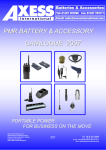
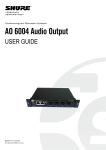
![Stealth Protect Series catalogue 2011_We[...]](http://vs1.manualzilla.com/store/data/005809212_1-caf297493bfcf938dba2b64bb0d79842-150x150.png)
